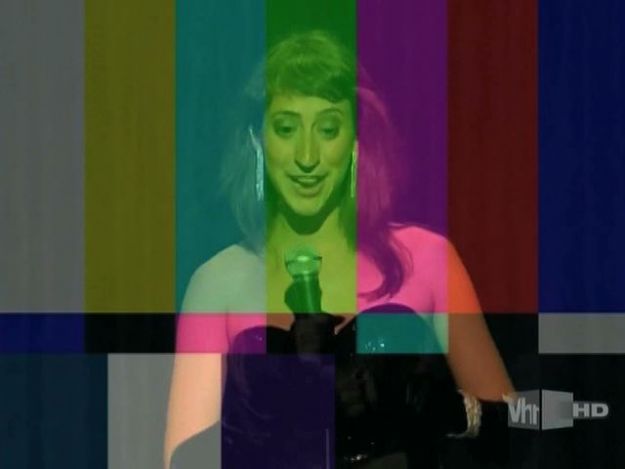“You may or may not have real feelings for me,” says Frank Maresca in an episode of the VH1 show Frank the Entertainer...In a Basement Affair. Addressing the group of women competing to win his love, Frank goes on to note that “my feelings are the test here.” One of the women hearing these words and competing for these feelings is the artist Ann Hirsch, here playing a role as Annie, and presenting this show in the video Here for You (Or My Brief Love Affair with Frank Maresca) (2010), part of her current solo show at the MIT List Visual Arts Center. The video is not a singular episode of the VH1 show, but footage from several episodes spliced with other images, like Hirsch floating in a swimming pool or walking through a stand of trees. What Frank says, though, is what is really at the heart of the video and the installation as a whole: feelings.
Specifically, how feelings come to serve as a form of documentation, also recorded here in the video installation Scandalishious (2008-2009) and the project Twelve (2013). Here for You (Or My Brief Love Affair with Frank Maresca) (2010) documents Frank's reception of the women on the show, where his feelings are the only criteria for success. This notion presents a less frequently considered aspect of affect management, that true success sometimes lies not only in an ability to manage one’s own affect, but in one’s ability to produce certain affects in others. Affect as a criteria for success is a theme that spills over from Here For You (Or My Brief Love Affair With Frank Maresca) and into the exhibit as a whole: considering Scandalishious (2008-2009), which consists of a four-monitor installation of Hirsch’s own videos, posted to YouTube as the persona of Caroline, a running loop of the comments these videos accrue and two screens playing videos posted to YouTube by Caroline’s viewers, at her request, it becomes difficult not to consider affect as the measure of success here as well. Because this installation is not just within the context of reality TV or YouTube but reality TV and YouTube and art: the affective response of viewers measures success as a person, a performance and a performance of a person. Does Caroline, as a stereotypical (and self-proclaimed) hipster whose dance videos and clothing recommendations and occasional teary-eyed confessions demonstrate a near vapid obsession with herself, want to be liked? Or does Annie, on and through Frank the Entertainer, find more success and more ‘likeability’ even if she is ultimately kicked off the show?

Still from Here for You (Or My Brief Love Affair with Frank Maresca), 2010. Video, color, sound, 14 min. Courtesy the artist.
Likeability becomes a dense and deeply divided notion within the context of this show. Annie competes with other women to win Frank liking her more. Caroline competes with other women, who may be less physically present but are nonetheless felt as idealized and hypothetical presences, to achieve measures of likeability like number of views. In a third piece in the installation, an app that narrates a relationship that develops in an AOL chatroom between an adolescent girl and a much older man, ‘likeability’ can likewise be thought of as playing into the negotiation of that relationship. Each piece presents different performances of women who must tailor their performance to the specific characteristics of likeability the situation calls for. Annie, in one scene, lets a few of the other competitors give her a makeover before a date with Frank, trading the more natural or artistic look the producers cast her for, for a more heavily made-up presentation. Caroline, however, complicates any notion of likeability as a quality that can be rooted in only the presentation of self, through coded aesthetics and visible markers like whether Annie wears make up or not, because Caroline ultimately presents the viewer back to themselves. The success of Scandalishious lies in Hirsch’s ability to cohesively and completely present a form of femininity that some feel compelled to hate and others feel compelled to defend.
These attitudes play out in the comments. Beneath the monitor showing Caroline’s own videos, we are shown a scrolling loop of the comments the video gathers. Falling mostly into three main groups, the comments be categorized as: expressions of vitriolic hatred for Caroline, most objecting to her “exhibitionism” (i.e. “Can you imagine having to love this exhibitionism all the time”), her ugliness or the sound of her voice; expressions of defense against this hatred (which occasionally but not always includes outright support or adoration); and expressions of defense against this hatred that perhaps only inadvertently defend, by describing her behavior as mental illness or noting that she looks like she’s on drugs. And yet, the very existence of these comments demonstrates the necessity people feel to make them. Can likeability be expressed as hatred?
And whose feelings, exactly, are behind and being represented by these comments? The complicated nature of viewing Scandalishious stems precisely from this re-presentation. By seeing, simultaneously, the video installations as art within the gallery, the videos from other viewers on YouTube, edited video from reality TV, the YouTube videos posted by Caroline and the comments themselves, all under the banner “List Projects: Ann Hirsch,” the nature of the feelings being presented shifts. One can see the reactions of people from anonymous commentators to reality TV producers and the reflection of these attitudes in one’s own responses: acceptance to stereotyping to rejection. It is also worth asking the complicated question of how Hirsch’s body itself comes to function in producing these reactions. It is not just Caroline or Annie’s clothing and makeup and behaviors that fit them more or less seamlessly into the situations they’re a part of, but the fact that Hirsch is doing this fitting with and through a body that is young, thin and white: it is a body already with the privilege of seamlessness. And one cannot help but question how this privilege must fundamentally alter any notion of “likeability” and the success possible within such a matrix of affect.
It would be easy to leave the question of likeability as being inextricably tied to the media and mediatized performances they are embedded in, as purely produced by the media itself. But the videos produced by people for Caroline, videos of them dancing or showing her their houses or just talking, at least partially refutes this notion: these are things these people feel like doing, compelled by feeling and not simply compelled by the demands of reality TV or art. Why? There is something almost more genuine and less performative at play here. What is it, exactly, about the kind of femininity presented over and over here that inspires such reactions? Again, it would be too easy to call this only sexism and leave it at that. Hirsch provides no easy answers either, and the success of this concise show lies in her ability to present the questions and such a wide range of responses. “You may or may not have true feelings for me,” but there are certainly a lot of feelings here to have.
List Projects: Ann Hirsch is on view through February 21, 2016.
- Still from Here for You (Or My Brief Love Affair with Frank Maresca), 2010. Video, color, sound, 14 min. Courtesy the artist.
- Installation view: List Projects: Ann Hirsch at MIT List Visual Arts Center. Photo: MIT List Visual Arts Center
- Installation view: List Projects: Ann Hirsch at MIT List Visual Arts Center. Photo: MIT List Visual Arts Center
- Installation view: List Projects: Ann Hirsch at MIT List Visual Arts Center. Photo: MIT List Visual Arts Center
- Still from Here for You (Or My Brief Love Affair with Frank Maresca), 2010. Video, color, sound, 14 min. Courtesy the artist.
- Still from Here for You (Or My Brief Love Affair with Frank Maresca), 2010. Video, color, sound, 14 min. Courtesy the artist.
- Still from Scandalishious, 2008-2009. Video, color, sound, 42.5 min. Courtesy the artist.
- Still from Scandalishious, 2008-2009. Video, color, sound, 42.5 min. Courtesy the artist.













1 Comment
Frank didn’t say “You may or may not have real feelings for me” to Annie; he said he knew her feelings for him were real. He was addressing another contestant in the quote.